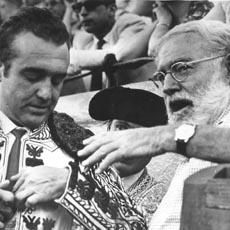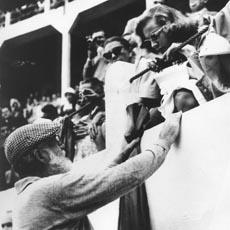
SHIRLEY GRIFFITH: I'm Shirley Griffith.
FRANK OLIVER: And I'm Frank Oliver with People in America, a Special English program about people who were important in the history of the United States. Today, we tell about the life of writer Ernest Hemingway.
(MUSIC)
SHIRLEY GRIFFITH: "A writer is always alone, always an outsider," Ernest Hemingway said. Others said that of the many people he created in his books, Hemingway was his own best creation.
Ernest Hemingway was born in 1899. He grew up in Oak Park, Illinois, near the middle western city of Chicago. He was the second child in a family of six. His father was a doctor. His mother liked to paint and play the piano.
Each summer the family traveled to their holiday home in northern Michigan. Ernest's father taught him how to catch fish, hunt, set up a camp and cook over a fire.
At home in Oak Park, Ernest wrote for his school newspaper. He tried to write like a famous sports writer of that time, Ring Lardner. He developed his writing skills this way.
FRANK OLIVER: In 1917, Hemingway decided not to go to a university. The United States had just entered World War One and he wanted to join the army. But the army rejected him because his eyesight was not good enough.

Ernest found a job with the Kansas City Star newspaper in Kansas City, Missouri. He reported news from the hospital, police headquarters, and the railroad station. One reporter remembered: "Hemingway liked to be where the action was."
The Kansas City Star demanded that its reporters write short sentences. It wanted reporters to see the unusual details in an incident. Hemingway quickly learned to do both.
He worked for the newspaper only nine months before he joined the Red Cross to help on the battlefields of Europe. His job was to drive a Red Cross truck carrying wounded away from battle.
SHIRLEY GRIFFITH: The Red Cross sent him to Italy. Soon he saw his first wounded when an arms factory in Milan exploded. Later, he was sent to the battle front. He went as close to the fighting as possible to see how he would act in the face of danger. Before long, he was seriously wounded.
The war ended soon after he healed. Hemingway returned to the United States. Less than a year had passed since he went to Europe. But in that short time he had changed forever. He needed to write about what he had seen.
FRANK OLIVER: Ernest Hemingway left home for Chicago to prove to himself, and to his family, that he could earn a living from his writing.
But, he ran out of money and began to write for a newspaper again. The Canadian newspaper, the Toronto Star, liked his reports about life in Chicago and paid him well.
SHIRLEY GRIFFITH: In Chicago, Hemingway met the writer Sherwood Anderson. Anderson was one of the first writers in America to write about the lives of common people. Hemingway saw that Anderson's stories showed life as it really was, the way Hemingway was trying to do.
Anderson gave Hemingway advice about his writing. He told Hemingway to move to Paris, where living was less costly. He said Paris was full of young artists and writers from all over the world.
In return for Anderson's kindness Hemingway wrote a book called "The Torrents of Spring." It makes fun of Anderson and the way he wrote. There was something in Hemingway that could not say "thank you" to anyone. He had to believe he did everything for himself, even when he knew others helped him.
(MUSIC)
FRANK OLIVER: Hemingway decided to move to Paris. But before he did he married a woman he had recently met. Her name was Hadley Richardson.

Paris was cold and gray when Hemingway and his new wife arrived in 1921. They lived in one of the poorer parts of the city. Their rooms were small and had no running water. But the Toronto Star employed him as its European reporter, so there was enough money for the two of them to live. And the job gave Hemingway time to write his stories.
SHIRLEY GRIFFITH: Hemingway enjoyed exploring Paris, making new friends, learning French customs and sports. Some new friends were artists and writers who had come to Paris in the 1920s. Among them were poet Ezra Pound, and writers Gertrude Stein, John dos Passos, and F. Scott Fitzgerald. They quickly saw that Hemingway was a good writer. They helped him publish his stories in the United States. He was thankful for their support at the time, but later denied that he had received help.
As a reporter, Hemingway traveled all over Europe. He wrote about politics. He wrote about peace conferences and border disputes. And he wrote about sports, skiing and fishing. Later he would write about bull fighting in Spain. The Toronto Star was pleased with his work, and wanted more of his reports. But Hemingway was busy with his own writing.
He said: "Sometimes, I would start a new story and could not get it going. Then I would stand and look out over the roofs of Paris and think. I would say to myself: 'All you have to do is write one true sentence. Write the truest sentence you know.' So finally, I would write a true sentence and go on from there. It was a wonderful feeling when I had worked well. "
FRANK OLIVER: Hemingway's first book of stories was called "In Our Time." It included a story called "Big Two-Hearted River," about the effect of war on a young man. It tells about the young man taking a long fishing trip in Michigan. Hemingway had learned from his father when he was a boy about living in the wild.
The story is about two kinds of rivers. One is calm and clear. It is where the young man fishes. The other is dark. It is a swamp, a threatening place.
The story shows the young man trying to forget his past. He is also trying to forget the war. Yet he never really speaks about it. The reader learns about the young man, not because Hemingway tells us what the young man thinks, but because he shows the young man learning about himself.
"Big Two-Hearted River" is considered one of the best modern American stories. It is often published in collections of best writing.
SHIRLEY GRIFFITH: After the book was published in 1925, Hadley and Hemingway returned to the United States for the birth of their son. They quickly returned to Paris.
Hemingway was working on a long story. He wanted to publish a novel so he would be recognized as a serious writer. And he wanted the money a novel would earn.
The novel was called "The Sun Also Rises." It is about young Americans in Europe after World War One. The war had destroyed their dreams. And it had given them nothing to replace those dreams. The writer Gertrude Stein later called these people members of "The Lost Generation. "

FRANK OLIVER: The book was an immediate success. At the age of 25 Ernest Hemingway was famous.
Many people, however, could not recognize Hemingway's art because they did not like what he wrote about. Hemingway's sentences were short, the way he had been taught to write at the Kansas City Star newspaper. He wrote about what he knew and felt. He used few descriptive words. His statements were clear and easily understood.
He had learned from earlier writers, like Ring Lardner and Sherwood Anderson. But Hemingway brought something new to his writing. He was able to paint in words what he saw and felt. In later books, sometimes he missed. Sometimes he even looked foolish. But when he was right he was almost perfect.
(MUSIC)
SHIRLEY GRIFFITH: With the success of his novel, Hemingway became even more popular in Paris. Many people came to see him. One was an American woman, Pauline Pfeiffer. She became Hadley's friend. Then Pauline fell in love with Hemingway.
Hemingway and Pauline saw each other secretly. One time, they went away together on a short trip. Years later, Hemingway wrote about returning home after that trip: "When I saw Hadley again, I wished I had died before I ever loved anyone but her. She was smiling and the sun was on her lovely face. "
But the marriage was over. Ernest Hemingway and Hadley separated. She kept their son. He agreed to give her money he earned from his books. In later years, he looked back at his marriage to Hadley as the happiest time of his life.
(MUSIC)
FRANK OLIVER: This People in America program was written by Richard Thorman and Bill Rogers. I'm Frank Oliver.
SHIRLEY GRIFFITH: And I'm Shirley Griffith. Join us again next week for the final part of the story of Ernest Hemingway in Special English on the Voice of America.
Robert Frost, 1874-1963: celebrating national poetry month with one of America's most famous poets
F. Scott Fitzgerald (1896-1940): he wrote about the 'roaring twenties,' America's wildest party
Erest Hemingway: A famous writer of the 20th century
American history: the 1920's were an active and important period for the American arts
(来源:VOA 编辑:崔旭燕)
